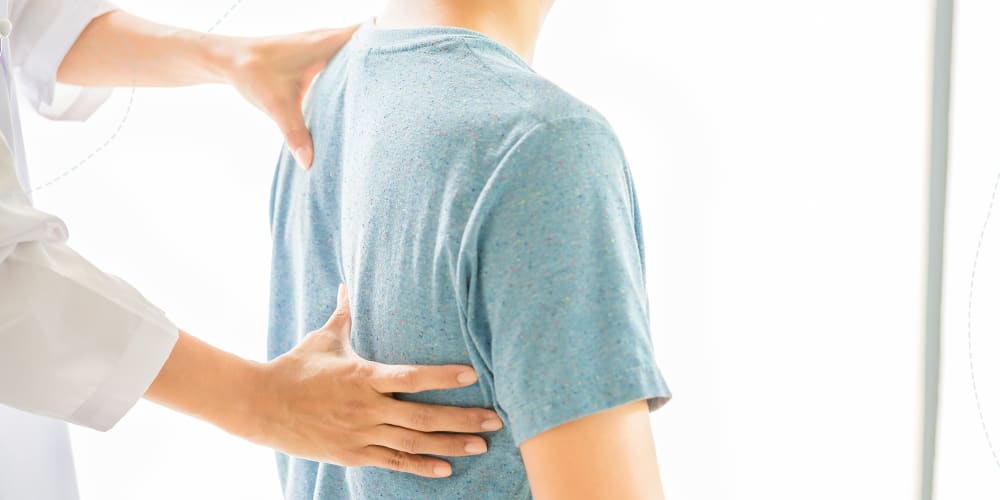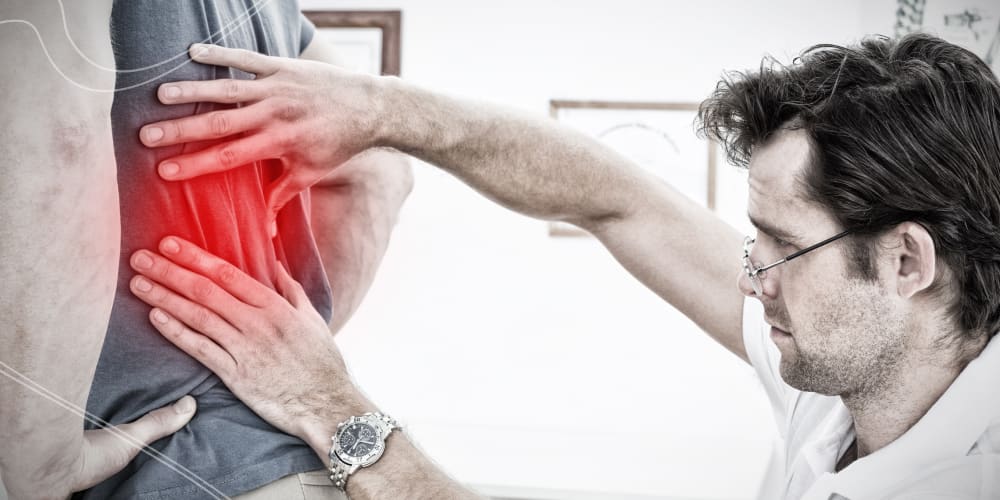Radiculitis or radiculopathy is a complex of specific symptoms associated with compression of the nerve roots extending from the spinal cord. The pathological process can be located in any part of the spinal column, but it is often localized in the lumbosacral region and called lumbar radiculopathy. This zone experiences the maximum load when the body is upright and is more prone to osteochondrosis and related diseases.
The vertebral column consists of individual vertebrae separated by cartilaginous discs. Inside the hollow canal is the spinal cord, from which the anterior and posterior nerve roots extend on each side. The former is responsible for motor functions, and the latter for sensitivity. They pass in special channels between the vertebrae and merge into a single spinal nerve, the branches responsible for one or another part of the body. Types of radiculopathy:
- Cervical (common);
- Thoracic symptoms;
- Cervicothoracic;
- Lumbar radiculopathy;
- Lumbosacral;
- Combined form (common);
Radiculopathy occurs in two stages:
- At the first stage, neurological, there is an increase in sensitivity, sharp and unexpected sharp pains, characteristic muscle tension, soreness of the paravertebral points when pressed.
- At the second stage, neurotic, there is a decrease in sensitivity in the area of innervation of nerve bundles formed from damaged roots. During a medical examination, the extinction of the periosteal reflex is revealed, and then partial hypotrophy is diagnosed. Muscle tension and intense pain characteristic of the first stage are preserved.
Symptoms of radiculopathy
Each type of radiculopathy is characterized by the presence of a certain set of symptoms.
The general symptom is pains of varying severity. The pain can range from not too intense to quite significant. Acute pain often restricts limb and body mobility and makes it impossible to lead a normal life, which affects the patient’s quality of life.
Most often, acute pain occurs in the morning- this could be:
- Pain in the neck;
- Headache (sometimes very intense);
- Shoulder pain;
- Arm pain;
- Soreness and/or stiffness in the neck muscles;
- Paresthesia (violation of sensitivity, accompanied by a burning sensation, tingling, numbness, cold);
- Metabolic disorders (dryness of the skin, their peeling, coldness of the skin when touching the affected area.)
If you have these symptoms, you should start treatment without delay. Don’t rely on homemade methods. They can give only a temporary effect and will not eliminate the cause of the disease.
Only a qualified neurologist will accurately determine the type of disease, prescribe an examination and adequate treatment.
Thoracic symptoms. Along with the general symptoms characteristic of all types of radiculopathy, with the thoracic form, there are:
- Girdle pain, pain between the shoulder blades, behind the sternum, and in the area of the lower ribs;
- Pain radiating to the shoulder and armpit;
- Pain radiating to the middle finger;
- Weakness of the triceps;
- During physical examination, revealing a decrease in the tricipital reflex.
It is difficult to diagnose the disease on your own. It should be borne in mind that the symptoms of thoracic radiculopathy resemble those of angina pectoris and other dangerous diseases. Self-treatment can cause irreparable harm.
Lumbar symptoms. The lumbosacral neurological syndrome is characterized (along with similar symptoms in other types):
- Intense pain in the foot, hip, and buttock;
- Acute pain in the lower back, radiating to the limb;
- Impaired motor function due to awkward tilting or sudden movement;
- Loss of sensitivity of the lower limb, weakening of the muscles of the lower limbs.
Causes of radiculopathy
Radiculitis is formed against a background of various negative factors. The following reasons for the appearance of radiculitis are often found:
- A sedentary lifestyle, as a result of a weak muscle corset;
- Age-related changes in the spine;
- The presence of metabolic, hormonal disruptions in the patient’s body;
- The course of chronic inflammatory processes;
- The curvature of the spinal column against the background of incorrect posture;
- Neoplasms in the spine or nearby tissues;
- The abnormal structure of the vertebrae, birth injuries (the cervical spine often suffers);
- The continuous loads of dynamic and static nature;
- The course of osteoporosis, osteochondrosis.
All of the above negative factors contribute to the onset of degenerative-dystrophic processes. Intervertebral discs lose moisture; then, elasticity, they are unable to perform a shock-absorbing function. Ultimately, the disc protrudes through the thinnest part of the annulus fibrosus. Soon the membrane ruptures completely; the nucleus pulposus protrudes outward.
This condition is considered the onset of protrusion, which provokes an intervertebral hernia. In both cases, the nerve roots are pinched; lumbar radiculopathy is formed.
Possible causes of the radicular syndrome:
- Mechanical injury;
- Weak back muscle;
- Metabolic disorders;
- Hormonal disorders;
- Age-related degenerative changes;
- Chronic inflammatory process;
- The consequences of surgery;
- Posture disorders (scoliosis, etc.);
- Heavy physical (dynamic and static) loads;
- Gravity loads;
- Spinal anomalies;
- Tumor processes;
- Narrowing of the spinal canal (due to displacement of the vertebrae);
- Narrowing of the foraminal (intervertebral) openings;
- Protrusion and hernia of intervertebral discs.
Diagnostics and treatment of radiculopathy
A neurologist at the initial visit conducts a neurological examination and finds:
- duration;
- the intensity of pain;
- the nature of sensitivity disorders;
- movement disorders.
To make an accurate diagnosis and prescribe an adequate treatment. If necessary, additional instrumental examinations can be prescribed in our clinic (X-ray examination, with the help of which the degree of deformity and degenerative-dystrophic changes, signs of instability, and displacement of the vertebrae) or in diagnostic centers of the city (magnetic resonance imaging, computed tomography, electromyography, etc.).
- Treatment of lumbar radiculopathy. The beginning of treatment requires compliance with complete rest and the use of various local remedies.
Since the effectiveness of treatment depends on establishing an accurate diagnosis and clarifying the cause that caused the compression of the nerve roots, contacting a qualified neurologist is a priority. - In some cases, the severity of the consequences will be less after quick help, which can be provided by an osteopathic doctor using manual or traction therapy (traction).
The next stage of treatment is the removal of pain syndrome. For this, various medications are used that can be prescribed in the form of injections, including intravenous drip in the comfortable conditions of a day hospital. - The third stage is a recovery course, which starts the physiological restoration of nerves, spinal roots, and cartilaginous tissue of intervertebral discs. Patients are recommended to get massages, physiotherapy, and reflexology.
Good results are obtained by:
- psychotherapy;
- massage;
- exercise therapy;
- swimming;
- physiotherapy;
- spa treatment (balneological resorts);
- galvanization;
- phonophoresis;
- amplipulse therapy;
- magnetotherapy;
- laser therapy;
- and laser magnetotherapy.
For aftercare and prevention of recurrent attacks, radon, mineral, and pearl baths are prescribed.
Prognosis of radiculopathy
In most cases, the prognosis is good. However, in some cases, patients are referred for consultation with doctors, neurosurgeons, and orthopedists.
Adverse factors:
- Elderly age.
- Prolonged static or physical activity.
- Whiplash.
- Tobacco smoking.
- Developmental anomalies.
- Prevention and recommendations.
- Recommendations are general and cannot be used for self-medication.
Currently, there are many modern and effective methods. Only a qualified neurologist can determine the appropriateness of their appointment.
FAQ
Is radiculopathy permanent?
Any radiculopathy is treatable, but you must remember that it is crucial to see a doctor on time.
Is it possible to warm the lower back with a heating pad for radiculopathy?
During an exacerbation of radiculopathy, it is recommended to keep the lower back warm. However, warming with a heating pad is not recommended; this can worsen the swelling of the roots and lead to increased pain. You can use special belts, including those made from dog hair, etc.
What painkillers can I take for sciatica if you have a stomach ulcer?
Many drugs used in exacerbation of radiculopathy are not recommended for patients with a history of gastric ulcer and duodenal ulcer. Only a doctor can prescribe adequate treatment after an examination. Do not self-medicate.
How do you know that you have radiculitis?
Symptoms of sciatica will help determine:
- increased pain during movement with spread to other parts of the body;
- significant limitation of mobility up to the complete inability to move;
- at the site of the lesion, the sensitivity of the skin is disturbed.












Please, leave your review
Write a comment: